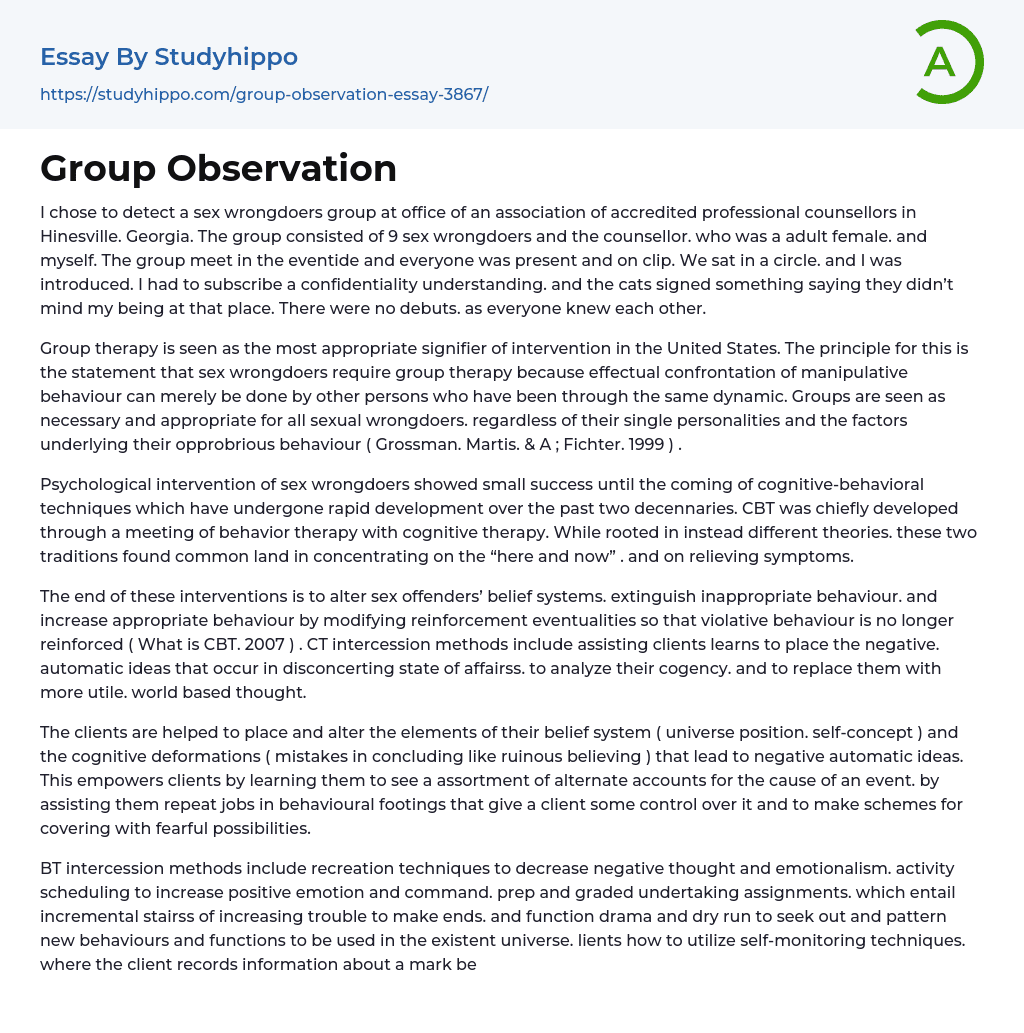I selected to identify a group of sex offenders at an office of an accredited professional counselors association in Hinesville, Georgia. The group consisted of nine sex offenders, one female counselor, and myself. We gathered in the evening and everyone was present and punctual. We sat in a circle and I was introduced. I had to sign a confidentiality agreement, while the offenders signed something stating they were okay with my presence. No introductions were necessary, as everyone already knew each other. Group therapy is considered the most suitable form of treatment in the United States. This belief stems from the argument that sex offenders require group therapy because only individuals who have gone through the same experiences can effectively confront their manipulative behaviors. Groups are seen as necessary and appropriate for all sex offenders, regardless of their distinct personalities and the underlying causes of their abusive behavio
...r (Grossman, Martis, & Fichter, 1999). Psychological treatment for sex offenders had limited success until cognitive-behavioral techniques emerged and rapidly developed over the past two decades. Cognitive-behavioral therapy (CBT) was primarily developed through merging behavior therapy with cognitive therapy. Although these two approaches were rooted in different theories, they found common ground in focusing on the present moment and alleviating symptoms.The goal of these interventions is to modify the belief systems of sex offenders, eliminate inappropriate behavior, and promote appropriate behavior by modifying reinforcement occurrences so that offensive behavior no longer receives reinforcement (What is CBT, 2007). CT intervention methods involve helping clients identify negative automatic thoughts that occur in distressing situations, analyze their validity, and replace them with more useful, reality-based thinking. Clients are also assisted i
identifying and changing elements of their belief system (world view, self-concept) and cognitive distortions (errors in reasoning such as catastrophic thinking) that lead to negative automatic thoughts. This empowers clients by teaching them to consider a variety of alternative explanations for the cause of an event, helping them reframe problems in behavioral terms to give clients some control over them, and developing strategies for dealing with fearful possibilities. BT intervention methods include relaxation techniques to reduce negative thoughts and emotions, activity scheduling to increase positive emotions and control, homework and graded task assignments which involve increasing levels of difficulty to achieve goals, and role play and rehearsal to explore and practice new behaviors and roles to be used in the real world. Clients are taught self-monitoring techniques where they record information about a target behavior and stimulus control.The alteration or removal of a stimulus-response connection in order to increase or eliminate a desired response (Fraum, 2011). I observed the counselor using these interventions during the group. One of the goals of the group is to prevent reoffenses. When the group started, the first thing the counselor asked was if any members had any "Red Flags" during the week. The Red Flag serves as a form of self-monitoring technique, indicating when a member is in a dangerous situation and must stop their behavior or leave the area. A few members shared their experiences and how they solved the problem. The group was in the working phase. One topic for discussion was why a member had failed a mandatory polygraph test, and the member revealed a reaction to the words child pornography. Seven members provided feedback. According
to Corey, Corey, & Corey (2010), during the working phase, members trust each other, goals are clear and specific, individuals feel comfortable contributing to others' work, there is a willingness to share vulnerable information, feedback is given and accepted without defensiveness, members feel hopeful, there is an awareness of the group process, communication is clear and direct, and the focus is on the present moment. The group exhibited these characteristics and more.
- Psychological Trauma essays
- Physical therapy essays
- Cold essays
- Experiment essays
- Explorer essays
- Hypothesis essays
- Observation essays
- Qualitative Research essays
- Research Methods essays
- Theory essays
- Abnormal Psychology essays
- Abraham Maslow essays
- Attachment Theory essays
- Authority essays
- Behaviorism essays
- Classical Conditioning essays
- Cognitive Psychology essays
- Counseling essays
- Developmental Psychology essays
- Educational Psychology essays
- Erik Erikson essays
- Family Therapy essays
- Jean Piaget essays
- Maslow's Hierarchy Of Needs essays
- Mental Health essays
- Operant Conditioning essays
- Personality Psychology essays
- Positive Psychology essays
- Psychoanalysis essays
- Psychotherapy essays
- Sigmund Freud essays
- Social Psychology essays
- Stanford Prison Experiment essays
- Supersize Me essays
- alternative medicine essays
- Aspirin essays
- Cannabis essays
- Cardiology essays
- Cloning essays
- Dentist essays
- drugs essays
- Hemoglobin essays
- Medical essays
- Medical Ethics essays
- Organ Donation essays
- Patient essays
- Pharmacology essays
- Plastic Surgery essays
- Surgery essays
- Therapy essays




